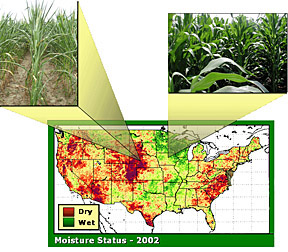This page has been archived and is being provided for reference purposes only. The page is no longer being updated, and therefore, links on the page may be invalid.
|
|
|
|
Taking Earth's Temperature via Satellite
By Don ComisAugust 12, 2008
Imagine adding a thermometer to GoogleTM Earth. That's the vision of Agricultural Research Service (ARS) scientists Martha Anderson and Bill Kustas, who see the need for high-resolution thermal infrared imaging tools--such as those aboard the aging Landsat satellites--as vital to monitoring earth's health.
These thermal data are especially important given the combination of global warming and the growing population's increasing demand for water.
Anderson is a physical scientist and Kustas is a hydrologist at the ARS Hydrology and Remote Sensing Laboratory in Beltsville, Md. Based on remote sensing experiments over the past two decades, Anderson and Kustas see the potential to combine results from a suite of satellites for regional monitoring of evapotranspiration and drought on a daily basis.
As with GoogleTM Earth, users could zoom in from the continental scale to a single field or irrigation operation.
Thermal remote sensing of the earth's land surface and plant canopies from satellites is a valuable way to diagnose water stress and drought conditions. Also, thermal imaging can be used in lieu of precipitation data, providing much-needed information on soil moisture status in data-poor parts of the world.
The ability to map evapotranspiration and soil moisture via satellite has broad applications in monitoring drought and water consumption, administering irrigation projects, predicting water demand, and providing information for hydrological and weather forecast computer models.
Landsat 5 is more than 24 years old; Landsat 7 is 9 years old, but already has operational problems. When the Landsat satellites fail, which could happen at any time, there will be a gap in high-resolution thermal measurements until the National Aeronautics and Space Administration launches its HypspIRI satellite, possibly sometime between 2013 and 2020.
An article on this research recently appeared in Eos, a weekly newspaper published by the American Geophysical Union.
ARS is a scientific research agency of the U.S. Department of Agriculture.

